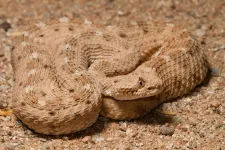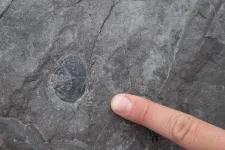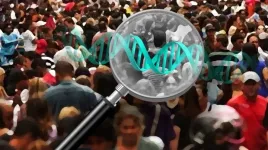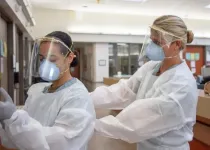(Press-News.org) Most snakes get from A to B by bending their bodies into S-shapes and slithering forward headfirst. A few species, however -- found in the deserts of North America, Africa and the Middle East -- have an odder way of getting around. Known as "sidewinders," these snakes lead with their mid-sections instead of their heads, slinking sideways across loose sand.
Scientists took a microscopic look at the skin of sidewinders to see if it plays a role in their unique method of movement. They discovered that sidewinders' bellies are studded with tiny pits and have few, if any, of the tiny spikes found on the bellies of other snakes.
The Proceedings of the National Academy of Sciences published the discovery, which includes a mathematical model linking these distinct structures to function.
"The specialized locomotion of sidewinders evolved independently in different species in different parts of the world, suggesting that sidewinding is a good solution to a problem," says Jennifer Rieser, assistant professor of physics at Emory University and a first author of the study. "Understanding how and why this example of convergent evolution works may allow us to adapt it for our own needs, such as building robots that can move in challenging environments."
Co-authors of the paper include Joseph Mendelson, a herpetologist and the director of research at Zoo Atlanta; evolutionary biologist Jessica Tingle (University of California, Riverside); and physicists Daniel Goldman (Georgia Tech) and co-first author Tai-De Li (City University of New York).
Rieser's research interests bring together the physics of soft matter -- flowable materials like sand -- and organismal biology. She studies how animals' surfaces interact with the flowable materials in their environments to get around. Insights from her research may lead to improvements in human technology.
Snakes, and other limbless locomotors, are particularly interesting to Rieser. "Even though snakes have a relatively simple body plan, they are able to navigate a variety of habitats successfully," she says. Their long, flexible bodies are inspiring work on "snake" robots for everything from surgical procedures to search-and-rescue missions in collapsed buildings, she adds.
In a previous paper, Rieser and colleagues found that designing robots to move in serpentine ways may help them to avoid catastrophe when they collide with objects in their path.
Sidewinders offered her a chance to dig further into how nature has evolved ways to move across loose sand and other soft matter.
Most snakes tend to keep their bellies largely in contact with the ground as they slide forward, bending their bodies from their heads to their tails. A sidewinder, however, lifts its midsection off the ground, shifting it in a sideways direction.
Previous studies have hypothesized that sidewinding may allow a snake to move better on sandy slopes. "The thought is that sidewinders spread out the forces that their bodies impart to the ground as they move so that they don't cause a sand dune to avalanche as they move across it," Rieser explains.
For the current paper, Rieser and her colleagues investigated whether sidewinders' skin might also play a role in their unique movement style.
They focused on three species of sidewinders, all of them vipers, in residence at zoos: The sidewinder rattlesnake (Crotalus cerastes), found in the deserts of the Southwestern United States and northern Mexico; and the Saharan horned viper (Cerastes cerastes) and the Saharan sand viper (Cerastes vipera), both from the deserts of north Africa.
Skins shed from the sidewinders were collected and scanned with atomic force microscopy, a technique that provides resolution at the atomic level, on the order of fractions of a nanometer. For comparison, they also scanned snake skins shed from non-sidewinders.
As expected, the microscopy revealed tiny, head-to-tail pointing spikes on the skin of the non-sidewinders. Previous research had identified these micro spikes on a variety of other slithering snakes.
The current study, however, found that the skin of sidewinders is different. The two African sidewinders had micro pits on their bellies and no spikes. The skin of the sidewinder rattlesnake was also studded with tiny pits, along with a few, much smaller, spikes -- although far fewer spikes than those of the slithering snakes.
The researchers created a mathematical model to test how these different structures affect frictional interactions with a surface. The model showed that head-to-tail pointing spikes enhance the speed and distance of forward undulation but are detrimental to sidewinding.
"You can think about it like the ridges on corduroy material," Rieser says. "When you run your fingers along corduroy in the same direction as the ridges there is less friction than when you slide your fingers across the ridges."
The model also showed that the uniform, non-directional structure of the round pits enhanced sidewinding, but was not as efficient as spikes for forward undulation.
The research provides snapshots at different points in time of convergent evolution -- when different species independently evolve similar traits as a result of having to adapt to similar environments.
Rieser notes that American sandy deserts are much younger than those in Africa. The Mojave of North America accumulated sand about 20,000 years ago while sandy conditions appeared in the Sahara region at least seven million years ago.
"That may explain why the sidewinder rattlesnake still has a few micro spikes left on its belly," she says. "It has not had as much time to evolve specialized locomotion for a sandy environment as the two African species, that have already lost all of their spikes."
Engineers may also want to adapt their robot designs accordingly, Rieser adds. "Depending on what type of surface you need a robot to move on," she says, "you may want to consider designing its surface to have a particular texture to enhance its movement."
INFORMATION:
CAMBRIDGE -- The temperature of a planet is linked with the diversity of life that it can support. MIT geologists have now reconstructed a timeline of the Earth's temperature during the early Paleozoic era, between 510 and 440 million years ago -- a pivotal period when animals became abundant in a previously microbe-dominated world.
In a study appearing today in the Proceedings of the National Academy of Sciences, the researchers chart dips and peaks in the global temperature during the early Paleozoic. They report that these temperature variations coincide with the planet's ...
In a new study led by Yale Cancer Center, researchers have discovered a novel metabolic gatekeeper mechanism for leukemia. This mechanism depends on a molecule called PON2, which could lead to a new treatment for the disease. The findings were published online today in the Proceedings of the National Academy of Sciences (PNAS).
B cells are effector cells of the adaptive immune system and are marked by low energy levels, which prevent transformation to leukemia. In this study, Yale scientists identified high expression levels of the detoxifying lactonase ...
Philadelphia, February 1, 2021 - Researchers at Children's Hospital of Philadelphia (CHOP) have demonstrated that autism spectrum disorder (ASD) may be caused by defects in the mitochondria of brain cells. The findings were published online by the Proceedings of the National Academy of Sciences.
Multiple studies have revealed hundreds of mutations associated with autism spectrum disorder, but there is no consensus as to how these genetic changes cause the condition. Biochemical and physiological analyses have suggested that deficiencies in mitochondria, the "batteries" of the cell that produce ...
Scientists have identified a group of drugs that may help stop a leading cause of vision loss after making an unexpected discovery that overturns a fundamental belief about DNA.
The drugs, known as Nucleoside Reverse Transcriptase Inhibitors, or NRTIs, are commonly used to treat HIV. The new discovery suggests that they may be useful against dry macular degeneration as well, even though a virus does not cause that sight-stealing condition.
A review of four different health insurance databases suggests that people taking these drugs have significantly reduced risk of developing dry macular degeneration, a condition that affects ...
A 15-year experiment on Arctic shrubs in Greenland lends new understanding to an enduring ecological puzzle: How do species with similar needs and life histories occur together at large scales while excluding each other at small scales? The answer to this question has important implications for how climate change might shift species' distributions across the globe.
The study was published today in the journal PNAS and led by the University of California, Davis. Its findings also reveal trends related to carbon sequestration and carbon exchange as the Arctic becomes both greener and browner.
EXPANSION AND EXCLUSION
Like lines of traffic traveling the same roads at the same time without crashing into each ...
CLEVELAND - Evidence suggests particulate matter is the air pollutant which poses the greatest threat to global health. Studies have shown that exposure to particulate matter smaller than 2.5 microns is associated with acute and chronic elevations in blood pressure (BP) as well as hypertension. In the study "The Benefits of Intensive Versus Standard Blood Pressure Treatment According to Fine Particulate Matter Air Pollution Exposure" published this week in the journal Hypertension, researchers at University Hospitals (UH) and Case Western Reserve University (CWRU) ...
A paper by a multidisciplinary team of scientists affiliated with various Brazilian institutions, including the University of São Paulo (USP) and the National Cancer Institute (INCA), shows that people of African descent are less likely to find a donor in the National Register of Voluntary Bone Marrow Donors (REDOME) than people with predominantly European ancestry. The paper is published in Frontiers in Immunology.
REDOME is the world’s third-largest bone marrow bank, with more than 5 million registered voluntary donors.
According to the study, having mainly African genetic ancestry can reduce a person’s chances of finding a donor by up to 60%, and having African copies of HLA genes, which must be compatible with ...
Obesity and its duration are significant risk factors for type 2 diabetes, cardiovascular events, multiple cancers and decreased quality of life. According to the Centers for Disease Control and Prevention, obesity affects 20.6% of adolescents ages 12-19 in the United States, meaning a potential lifetime of dealing with this condition. Complications from obesity can also result in a potentially decreased life expectancy of five to 20 years for these youth. In a new study published in Pediatrics, researchers at Children's Hospital Colorado (Children's Colorado) have found that both younger and older adolescents have similar weight loss, resolution of high blood pressure and high cholesterol, nutritional impacts and improvement in quality of life after bariatric surgery. These results ...
Article Title: "Game theory to enhance stock management of Personal Protective Equipment (PPE) during the COVID-19 outbreak"
Funding: The authors received no specific funding for this work.
Competing Interests: The authors have declared that no competing interests exist.
Article URL: https://journals.plos.org/plosone/article?id=10.1371/journal.pone.0246110
INFORMATION: ...
Decoy protein intercepts spike of coronavirus
Virus prevented from infecting human cells
Protein may be new way to treat and prevent COVID-19
CHICAGO --- Northwestern Medicine scientists have developed a new protein that acts as a trickster to neutralize the COVID-19 infection in a human kidney organoid, a miniature organ made from stem cells in the lab.
The protein is a variant of ACE2 (angiotensin converting enzyme-2), the receptor the coronavirus uses to enter and infect human cells. The modified protein intercepts the S spike of the coronavirus and fools it into binding to it rather than the real ACE2 receptor in cell membranes. ...







